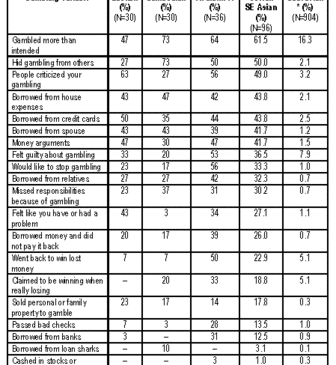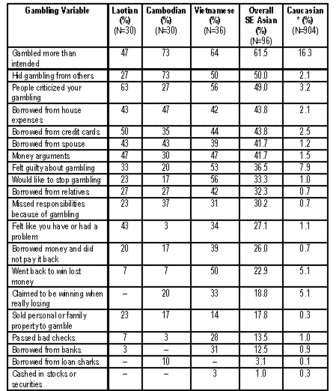According to the Diagnostic and Statistical Manual of the American Psychiatric Association (DSM-IV, 2000, p.671), pathological gambling is characterized by “persistent and recurrent maladaptive gambling behavior that disrupts personal, family, or vocational pursuits.” The disruption caused by gambling likely varies across communities because community standards for gambling behavior and its acceptability vary. However, we know little about variations in different communities and vulnerable populations. In particular, virtually no research has been conducted on gambling activities and problems among recent immigrant populations to the United States. This week, The Wager discusses a small study examining gambling participation and problems among South East Asian refugees in Connecticut (Petry, Armentano, Kuoch, Norinth, & Smith, 2003).
Social workers at three Connecticut community service organizations asked individuals attending the centers if they would complete a survey about gambling after hearing a description of the study. In each of the three organizations, which provide basic needs assessment and support as well as educational, recreational, and cultural activities for Laotians, Vietnamese, and Cambodians, approximately 80% of individuals agreed to participate. The final sample included 30 Laotians, 30 Cambodians, and 36 Vietnamese. Participants completed a questionnaire consisting of the South Oaks Gambling Screen (SOGS) (Lesieur & Blume, 1987) and questions about demographics and recent gambling activities. Native speakers of Lao, Khmer, and Vietnamese who were fluent in English translated the SOGS into their native languages. The questions were then read aloud to participants.
Petry et al.’s study is the first assessment of rates of gambling participation and problem gambling among South East Asian refugees to the U.S. Previous studies have found that members of ethnic minority groups experience higher rates of gambling problems than members of the majority ethnic group in a given country (e.g., Welte, Barnes, Wieczorek, Tidwell, & Parker, 2001). In the South East Asian refugee sample, 70% satisfied the SOGS criteria for lifetime problem (3-5 symptoms) or pathological (5+ symptoms) gambling and, unlike the general population, there were many more pathological (59%) than problem (11%) gamblers. Ninety five percent of the participants reported having gambled during the previous year and 93% reported having gambled during the previous two months. Petry et al. found differences between the types of gambling problems experienced by the Asian refugees and those typically found in Caucasian samples (Petry & Mallya, 2004, used for comparison). Among Caucasian samples in the same Connecticut area, the most frequently reported items on the SOGS were gambling more than intended, feeling guilty about gambling, claiming to be winning even when losing, and gambling to win back losses. As seen in Table 1, the most frequently reported items on the SOGS among South East Asians in the study were gambling more than intended, hiding gambling from others, having others criticize their gambling, and borrowing from house expense or
credit cards.
Table 1: Gambling problem symptoms endorsed among South East Asian refugees, by ethnic group (adapted from petry et al., 2003)
* “Caucasian” column adapted from a different study by Petry & Mallya, 2004
There are some limitations to the study, including the small size of the sample. The participants were not selected randomly; refugees who have gambling problems or have assimilated less into American culture might tend to attend ethnic community centers for support more than refugees without gambling problems, possibly resulting in an important response bias. Another potential limitation is the SOGS translation; when the questions were translated then read aloud to the participants in their native languages, some of the original meaning of the SOGS may have been altered or lost. However, the SOGS has been translated into more than 20 languages and studies have concluded that the SOGS “has generally demonstrated adequate psychometric properties when used in other cultures” (Petry et al., 2003, p.1143)1. Finally, the SOGS measures lifetime gambling rates that can overestimate the prevalence of gambling disorders, and, in the case of the refugees, might be measuring gambling problems that occurred prior to the participants’ immigration to the U.S.
Though the study did not directly test for differences between South East Asian refugees and Caucasians, the findings are intriguing given what we know about gambling and gambling problems among the general population in the US. The patterns of gambling-related symptoms were different for the South East Asian sample and the Caucasian sample, possibly due to the role that gambling plays in the different cultures. Perhaps the Asian refugees were more likely to hide their gambling and be criticized because in Asian culture, good fortune and luck should be greatly respected rather than exploited by uncontrollable gambling. The study suggests several reasons for the elevated lifetime prevalence of pathological gambling in the South East Asian population. Typically, gamblers with gambling related problems often bet as a way to escape from problems, trauma, and anxieties, perhaps similar to those which many refugees might have fled from in Asia. Dr. Jacobs, founder of the Project on Asian Problem Gambling, explains another possible reason for the high prevalence of pathological gambling: “Gambling has been a popular and culturally accepted form of recreation and social interaction within Asian communities for hundreds of years… Games are played at home among family and friends, and gambling is often associated with holidays and celebrations… [Casinos] create a very welcoming place for Asians and it becomes a magnet for people in those communities” (Blaine, 2002, p.6).
Gambling provides a form of recreation that is easily understood by immigrants immersed in a daunting foreign culture; casinos are well aware of this and market heavily to Asian communities in many areas. Ten buses run from New York’s Chinatown to six different casinos every day (Chin, 2005), while five buses travel daily from Boston’s Chinatown to a single casino starting at 9:30 a.m., making stops at four different Asian grocery stores in surrounding suburbs. Furthermore, casinos employ dealers who speak Asian languages, offer games in cultural traditions, and air television commercials on Asian-language stations. Petry et al.’s study raises important questions about the prevalence of pathological gambling among Asian populations and identifies the need for further research. Given casinos’ direct access to these Asian communities, future research and collaborations might investigate how casinos can provide a safe form of recreation for these communities while raising awareness of problem and pathological gambling.
What do you think? Comments on this article can be addressed to Audrey Bree Tse.
Notes
1. In order to test the validity of the translated version of the SOGS, Petry et al. administered the Khmer version to another group of 60 Cambodians, of which half were known to rarely gamble and half were known within their community to gamble problematically. Ninety-three percent of the presupposed nongamblers scored 0 on the SOGS, indicating nonproblem gambling, while 77% of the presupposed problem gamblers obtained scores in the pathological range.
References
American Psychiatric Association: Diagnostic and Statistical Manual of Mental Disorders, Fourth Edition, Text Revision. Washington, DC, American Psychiatric Association, 2000.
Blaine, D. (2002, November). Dealt a Bad Hand: Casinos Target the Bay Area’s Asian Communities to Pump Up Business. [X]PRESS, 6-7.
Chin, R. K. (2005). Chinatown Bus Information. Retrieved November 9, 2005, from http://www.nychinatown.org/ directory/m_bus.html#casino
Lesieur, H. R., & Blume, S. B. (1987). The South Oaks Gambling Screen (SOGS): a new instrument for the identification of pathological gamblers. American Journal of Psychiatry, 144, 1184-1188.
Petry, N. M., Armentano, C., Kuoch, T., Norinth, T., & Smith, L. (2003). Gambling participation and problems among South East Asian refugees to the United States. Psychiatric Services, 54(8), 1142-1148.
Petry, N. M., & Mallya, S. (2004). Gambling participation and problems among employees at a university health center. Journal of Gambling Studies, 20(2), 155-170.
Welte, J., Barnes, G., Wieczorek, W., Tidwell, M. C., & Parker, J. (2001). Alcohol and gambling pathology among U.S. adults: prevalence, demographic patterns and comorbidity. Journal of Studies on Alcohol, 62(5), 706-712.





